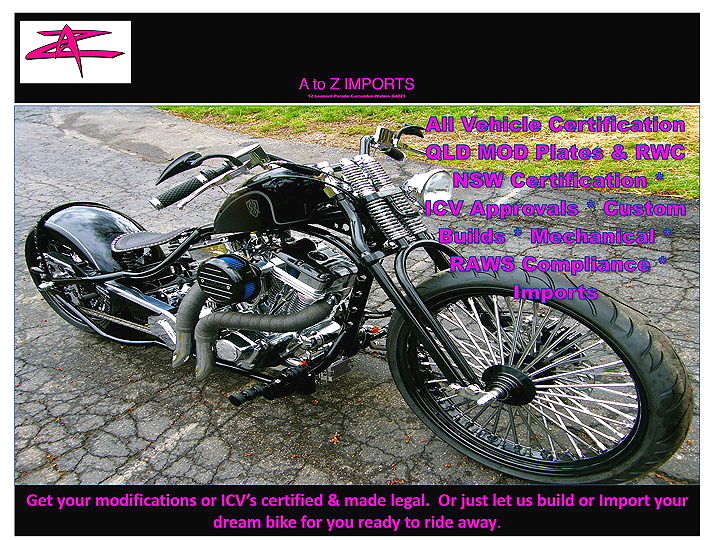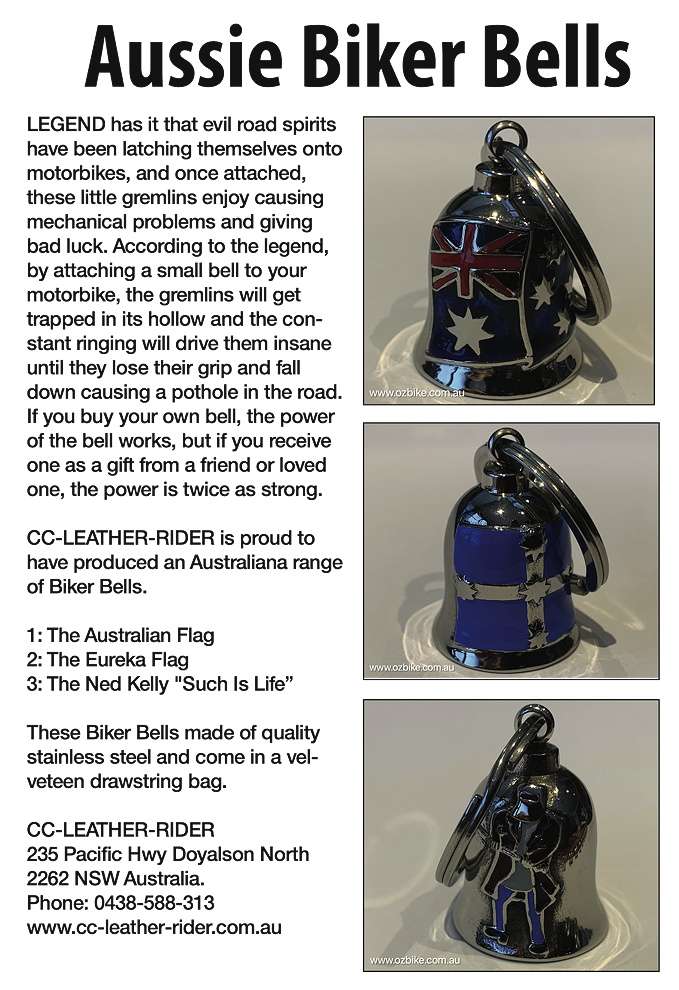Crusty Demons of Dirt in Oz

FREESTYLE Motocross is a dangerous extreme sport—the risk of injury is high as the riders are pushed to new levels every time they perform—and the Crusty Demons is the best Freestyle Motocross show in the world.
Knowing the Crusty Demons have a couple of Hellbound choppers in their show, we photographed one of them and interviewed Gary Reid, the man who rides it into the arena. We also interviewed Joel Balchin and Kain Saul, two of the very talented Australian riders in the Crusty Show.
The sport of motocross has been around for many years. It involves racing off-road bikes around man-made dirt tracks. In 1994 filmmakers Jon Freeman and Dana Nicholson accumulated footage to showcase a behind-the-scenes expose of the lifestyle of the American pro-motocross rider in action: soaring over sand dunes, mountains, houses, buses. The end result was the first video, Crusty Demons of Dirt. The launch of this video was to change the face of motocross forever.
Since then a new Crusty Demons video has been released every year as the riders learnt to perform more complicated dangerous tricks.
Not content with just a video, the Crusty Demons went on tour around the world. In Australia, when people hear the Crustys are coming to town, they turn out in droves because they know they’ll see the best riders performing this extreme sport. The Australian guys are definitely up there too—out of 10 top riders in the world, four would be Australian.
Gary Reid
I WAS a professional water-skier for years but I stopped doing it once I got married, settled in Canberra and started a family.
Eight years ago someone asked me if I had any ideas for the Royal Canberra Show and I said, “Yeah, fill the arena with water and do a water-ski show!” They all laughed.
I said. “Hey, I know some guys who ride dirt bikes. Maybe they can do some kind of motorbike show.” And that’s how I started the freestyle motocross team called ShowTime FXM, just doing small country shows. We’ve now grown to about 100 shows a year separate to the Crusty Demons Show.
I didn’t know I could announce. I hired a guy to announce my first couple of freestyle shows but he couldn’t do one, it was out west at Forbes, and my wife said to me, “Why you don’t just announce it yourself? It is only a small show; see how you go.” I was pretty nervous but I did it, and then I did another with 2500 people. From there I started to do more and more of my own shows.
When the Crusty Demons came out to Australia they had an American announcer but he lost his voice on the first night of the first show, so I was called in as a fill-in till he got his voice back—I’ve now been with them for five years!
The show is written in segments. Obviously Steve Scott, my co-announcer, and I start with the opening segment and we have individual rider segments, team riding, whatever, and we pretty much run the show from top to bottom for two and a half hours. We are actually moving around on the ramps, interviewing different riders in different spots.
This year we decided we wanted to use two custom choppers in the show so I had a meeting with the guy who imports Hellbound Choppers and we struck a deal.
The thing I really like about Hellbound is that their bikes are fully complied. The day mine was delivered to Canberra, I took it to rego, they punched in the VIN number and it came straight up on the computer.
The Hellbound chopper came with right-side-drive, 280 rear, 107 cube fully-polished S&S motor, billet wheels, chrome everything, braided lines, the whole lot.
I’ve ridden a lot of custom bikes over the years but this thing is just incredible.
It’s got four-spot brakes, it stops, it goes, it starts, everything works. It’s the closest thing you’ll get to a stock Harley; it’s just got the look everyone is after.
We took it to Browns Graphics in Wollongong. He does all the graphics for Crusty, all the signage on the sets and everything. We talked about ideas but eventually I said, “Look, it’s a bike for us to ride out on at the start of the show; it needs to have the Crusty theme; you know what you’re doing!”
Four days later—it was a rush job— I met him halfway between Sydney and Wollongong to pick up the tanks and guards. He did an awesome job. I rushed back to Canberra, put it all together and loaded it into a trailer.
It got to Brisbane for the opening show at five o’clock on the Friday night. We’d been practicing the show on a mini-bike because we didn’t have the chopper and everybody was getting stressed that it wasn’t going to make it. But it turned up, we did the show and it was a big hit.
Myself and Steve Scott rode the choppers out during the opening of the show to welcome the crowd, and we did a lap around the course. It was only a minor part of the show but when the curtains opened and the spotlights hit the choppers, you wouldn’t believe the crowd’s reaction: “Look at the choppers, look at the choppers!” I guess they didn’t expect that. You know, they came see the dirt bikes and didn’t expect to see two unreal-looking choppers cruise out on the field, and I was lucky enough to be riding one of them.
Joel Balchin
I GREW up in Quakers Hill in Sydney’s west. There was a fair bit of land out there then, and there were a couple of mini-bike clubs within 15 minutes of my house. That’s where I learnt to ride—at the Blacktown Mini-bike Club and on private land belonging to friends where we built tracks.
The club organised what they called a ‘minicana’ where the kids race around witch’s hats—going around and around in patterns. The last event of the day was the motocross, and then you were free to practice in the afternoon. Most kids raced the minicana until they turned 13, and then the motocross became their main focus.
I soon became interested in supercross. Motocross is a track using the natural terrain and you build a few jumps that fit the land; whereas supercross is riding on a man-made track, indoors most of the time, if not in a stadium, and all the jumps are planned. In supercross the consecutive jumps are much closer together and lot bigger and steeper.
In my early 20’s freestyle motocross came along. I was racing supercross and the jumping ability was pretty similar so it was an easy transition.
Freestyle motocross evolved when they started designing special take-off ramps that were consistent wherever you went. Now you could practice your tricks—learning how to take your hands off and fly through the air, not hanging onto the bike, and all that sort of the stuff—at home before the shows.
Terry Harp was the first to actually attempt the back flip using an almost vertical dirt up-ramp which required a lot of speed. Suddenly everyone realised it was possible to do the almost impossible.
Then Mike Maczger revolutionised the whole freestyle world when he built a foam pit and learnt how to back flip off one of the normal ramps we were using. The foam pit is a really nifty learning aid. It’s filled with a lot of foam—tons and tons of foam—and you jump your motorbike into it.
Doing a back flip is about commitment. It’s not a natural thing to do on a bike and the first two or tree times you sort of pull it, or don’t rotate properly. If you were landing on dirt you’d break every bone in your body. With the foam pits, you get to learn the motion without major injury. If anything goes wrong, you can bail. (you can see Kain using the foam pit at: www.youtube.com/watch?v=VJsHIaCR1xA)
After learning to flip backward and a host of other tricks, I started doing freestyle demonstrations around the place until the Crust Demons arrived from America. They were a few years ahead of us and we had to lift our game to be able to ride in such an extreme show. Because the Crust Demons are so successful in Australia, a big part of the crowd wanted to see Australians riding in the show as well, and I must admit, we are at a competitive level with the Americans at the moment.
As part of the Crust Demons, I have travelled to India and New Zealand; we are going to UK in the January and we’re trying to break into Europe.
At 29-years-old I’m considered a veteran of the sport. A lot of my Australian team mates are 20 to 24. I think the eldest rider we had on tour was Mike Jones from the USA. He recently retired at 40 so I reckon I’ve probably got a few years left in me yet as long any serious injuries don’t hold me back.
I have broken a lot of bones. I’m coming off the back-end of an injury right now. I was trying to do a back flip superman and I didn’t quite get back on the bike, came down pretty hard and broke a few ribs, broke a few toes and fractured some vertebrae. I guess if no-one ever fell off then no-one would come and see the show. I crashed in practice so it wasn’t even in front of a crowd. What a waste of a crash.
Kain Saul
I LIVE on the Gold Coast but I’m originally from Gladstone in Queensland which is where I started riding when I was about 14 years old. I’m 22 now so that was eight years ago.
I was pretty full-on into racing by the time I was 15, and in-between practicing, I started doing tricks on big dirt bikes; I was really getting into it.
I was one of the first people to flip in Australia on a big bike but I had a bit of a crash at zero gravity which nearly claimed my life. At about the same time, one of my mates died in an Australian motocross event.
When I’d recovered enough to start riding again, I started doing freestyle motocross on mini-bikes and got pretty good at it.
Doing motocross I’ve met a lot of the pro-riders—you get to meet a lot of great people along the way—and one day I got a call from the Crusty Demons asking me if I wanted to join. Are you joking! Of course I said yes.
I ended up flying over to America for a month, hanging around with Bubba (the fat clown from the videos), filming stuff, etc. Then I did a New Zealand tour with them.
The Crusty Demons don’t do any racing at all—it’s all about riding demonstrations. There are about 15 riders—probably 10 on big dirt bikes, four on quads, a snowmobile, and a couple on mini-bikes—and we all have our own tricks.
People don’t believe it, but the tricks they do on big bikes, you can do on a mini-bike. My best known trick includes the cordova flip. Front flips, back flips, I do them all on the mini-bike. (you can watch Kain do the cordova flip at: www.youtube.com/watch?v=VJsHIaCR1xA)
I’m not so sure about my future. Luckily, since I’ve been doing tricks on the mini-bikes, I haven’t been seriously hurt. Still, I’ve been thinking about getting back onto the big bikes. Only time will tell…
studio pics by Wall to Wall
















